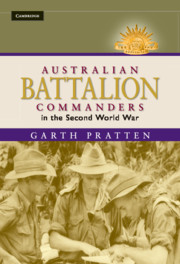Book contents
- Frontmatter
- Dedication
- Epigraph
- CONTENTS
- List of maps and figures
- Military symbols on maps
- ACKNOWLEDGEMENTS
- NOTES ON THE TEXT
- List of abbreviations
- INTRODUCTION
- CHAPTER 1 ‘COMPLETELY UNTRAINED FOR WAR’
- CHAPTER 2 THE FOUNDATIONS OF BATTALION COMMAND
- 3 ‘WE WERE LEARNING THEN’
- CHAPTER 4 DESERT EPILOGUE
- CHAPTER 5 VICTIMS OF CIRCUMSTANCE
- CHAPTER 6 ‘NO PLACE FOR HALF-HEARTED MEASURES’
- CHAPTER 7 ‘THERE IS NO MYSTERY IN JUNGLE FIGHTING’
- CHAPTER 8 ‘EXPERIENCED, TOUGHENED, COMPETENT’
- CONCLUSION
- APPENDIX 1 THE DEMOGRAPHICS OF AUSTRALIAN BATTALION COMMANDERS
- APPENDIX 2 PERIODS OF COMMAND
- NOTES
- BIBLIOGRAPHY
- INDEX
CHAPTER 6 - ‘NO PLACE FOR HALF-HEARTED MEASURES’
Australia and Papua 1940–42
Published online by Cambridge University Press: 18 December 2014
- Frontmatter
- Dedication
- Epigraph
- CONTENTS
- List of maps and figures
- Military symbols on maps
- ACKNOWLEDGEMENTS
- NOTES ON THE TEXT
- List of abbreviations
- INTRODUCTION
- CHAPTER 1 ‘COMPLETELY UNTRAINED FOR WAR’
- CHAPTER 2 THE FOUNDATIONS OF BATTALION COMMAND
- 3 ‘WE WERE LEARNING THEN’
- CHAPTER 4 DESERT EPILOGUE
- CHAPTER 5 VICTIMS OF CIRCUMSTANCE
- CHAPTER 6 ‘NO PLACE FOR HALF-HEARTED MEASURES’
- CHAPTER 7 ‘THERE IS NO MYSTERY IN JUNGLE FIGHTING’
- CHAPTER 8 ‘EXPERIENCED, TOUGHENED, COMPETENT’
- CONCLUSION
- APPENDIX 1 THE DEMOGRAPHICS OF AUSTRALIAN BATTALION COMMANDERS
- APPENDIX 2 PERIODS OF COMMAND
- NOTES
- BIBLIOGRAPHY
- INDEX
Summary
In March 1942 a circular issued by Headquarters Northern Command warned that the AMF could soon be required to ‘fight in defence of our hearths and homes, our own people and our own ideals’ against a ‘ruthless’ enemy: there was ‘no place for half-hearted measures in training or operations’. Australia’s year of crisis in the Second World War was 1942. The proximity of the Japanese threat exposed Australia’s lack of preparedness to fight what was perceived as a war of national survival. The same year also saw the full mobilisation of the Australian nation and the full mobilisation of its army. For the first time, the two components of the AMF – the all-volunteer AIF and the part-volunteer, part-conscripted militia – would go into action together. The discrepancies in equipment, training and leadership that had prevailed since the start of the war at last had to be tackled.
Sapped of its best officers and men by the AIF, the militia had been allowed to stagnate during 1940 and 1941. Most critically, the measures implemented to improve the standard of battalion command before the war were not applied rigorously or universally, and hence no concerted effort was made to develop command talent to replace that lost to the AIF. The solution adopted when the threat of invasion revealed the militia to be far below operational standards was to transfer large numbers of AIF officers, recently returned from the Middle East, into militia battalions. This included a wholesale replacement of militia battalion commanders with no precedent or antecedent in the army’s history. The introduction of AIF officers into the militia units, however, complicated command relationships. They had to establish their authority while still outsiders as well as implementing significant change in command appointments and procedures, discipline and tactics.
- Type
- Chapter
- Information
- Australian Battalion Commanders in the Second World War , pp. 165 - 196Publisher: Cambridge University PressPrint publication year: 2009



